A Case Study on Women’s Issues and Abortion Laws in Australia Today
VerifiedAdded on 2023/06/10
|10
|2024
|380
Case Study
AI Summary
This case study examines women's issues and abortion laws in Australia, focusing on the 2008 Abortion Law Reform Act in Victoria. It details the historical context, including the criminalization of abortion under the Crimes Act of 1958 and the subsequent Menhennitt Ruling. The analysis covers the VLRC's intentions to reform abortion laws, the impact of the 2008 Act, and the current scenario with varying abortion laws across Australian states. The study concludes by advocating for the legalization of abortion worldwide to empower women and ensure their reproductive rights, recommending economic and social empowerment as a solution to women's issues. Desklib provides students access to this document and many more resources.
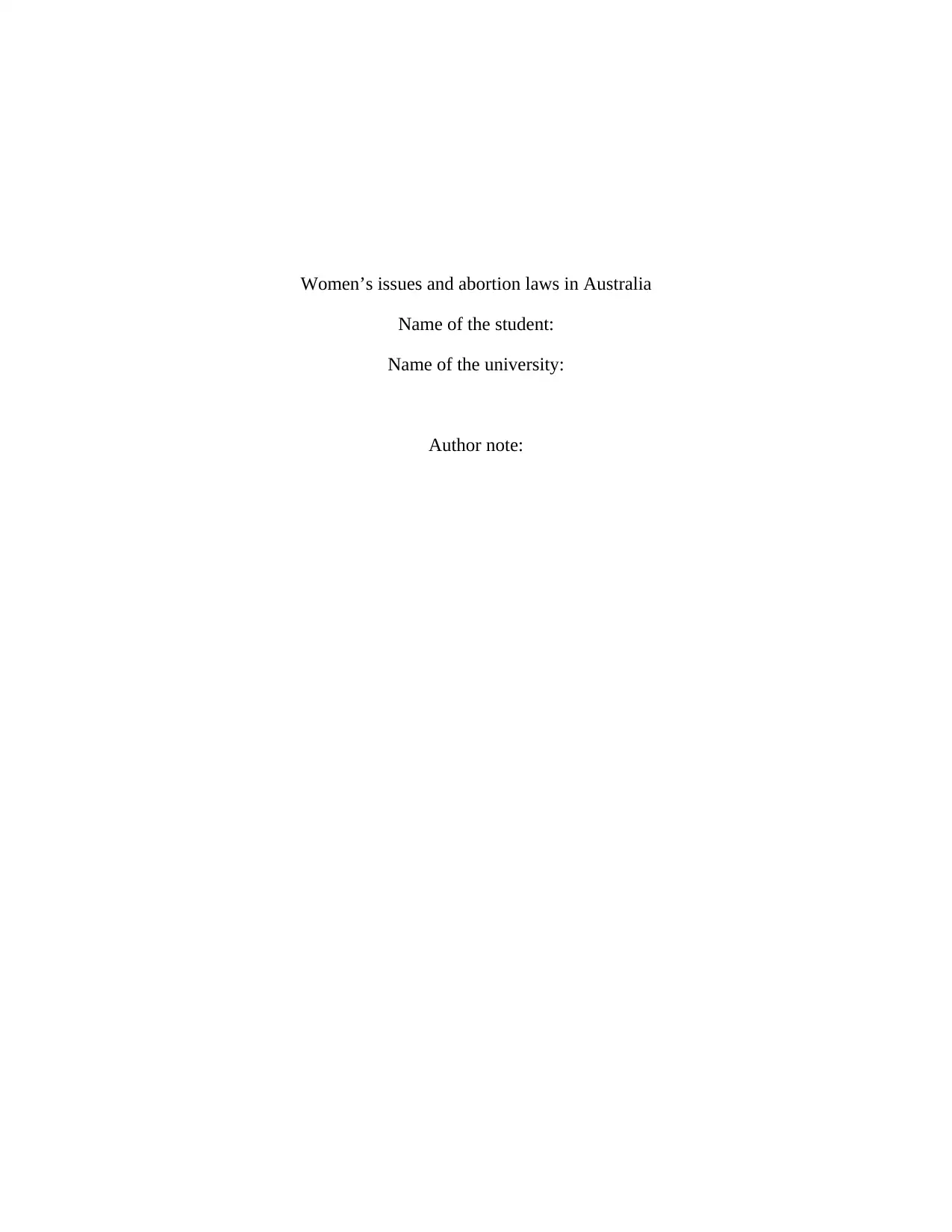
Women’s issues and abortion laws in Australia
Name of the student:
Name of the university:
Author note:
Name of the student:
Name of the university:
Author note:
Paraphrase This Document
Need a fresh take? Get an instant paraphrase of this document with our AI Paraphraser
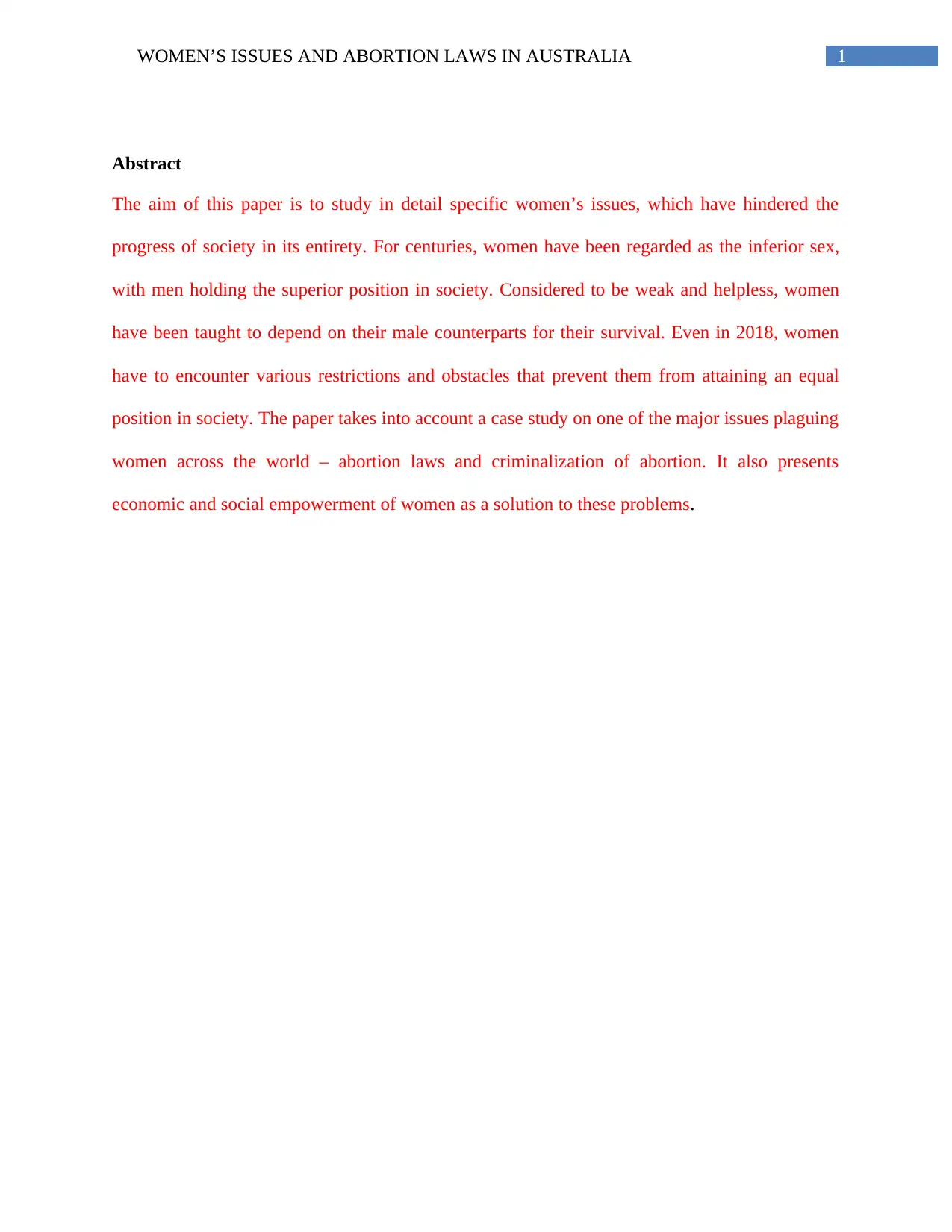
1WOMEN’S ISSUES AND ABORTION LAWS IN AUSTRALIA
Abstract
The aim of this paper is to study in detail specific women’s issues, which have hindered the
progress of society in its entirety. For centuries, women have been regarded as the inferior sex,
with men holding the superior position in society. Considered to be weak and helpless, women
have been taught to depend on their male counterparts for their survival. Even in 2018, women
have to encounter various restrictions and obstacles that prevent them from attaining an equal
position in society. The paper takes into account a case study on one of the major issues plaguing
women across the world – abortion laws and criminalization of abortion. It also presents
economic and social empowerment of women as a solution to these problems.
Abstract
The aim of this paper is to study in detail specific women’s issues, which have hindered the
progress of society in its entirety. For centuries, women have been regarded as the inferior sex,
with men holding the superior position in society. Considered to be weak and helpless, women
have been taught to depend on their male counterparts for their survival. Even in 2018, women
have to encounter various restrictions and obstacles that prevent them from attaining an equal
position in society. The paper takes into account a case study on one of the major issues plaguing
women across the world – abortion laws and criminalization of abortion. It also presents
economic and social empowerment of women as a solution to these problems.
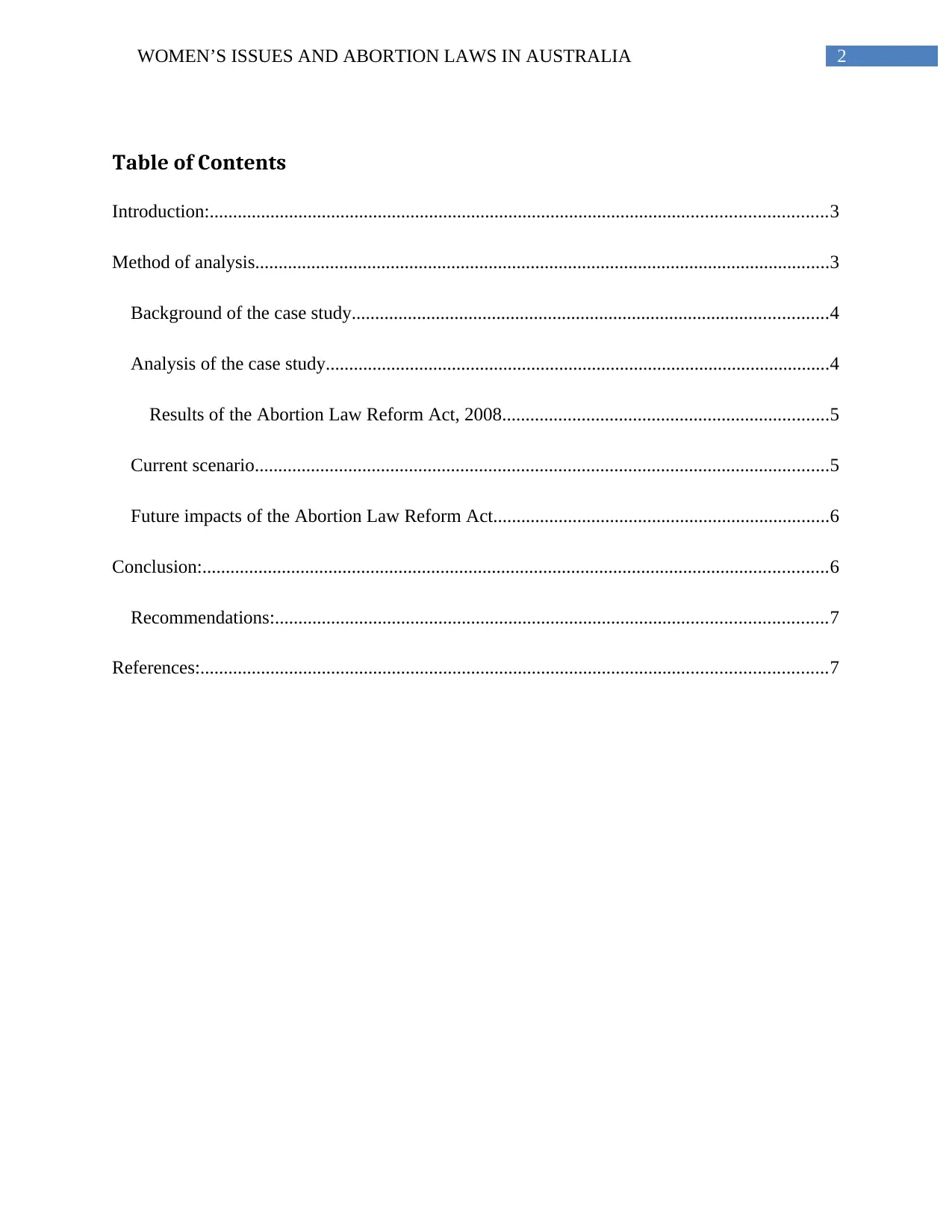
2WOMEN’S ISSUES AND ABORTION LAWS IN AUSTRALIA
Table of Contents
Introduction:....................................................................................................................................3
Method of analysis...........................................................................................................................3
Background of the case study......................................................................................................4
Analysis of the case study............................................................................................................4
Results of the Abortion Law Reform Act, 2008......................................................................5
Current scenario...........................................................................................................................5
Future impacts of the Abortion Law Reform Act........................................................................6
Conclusion:......................................................................................................................................6
Recommendations:......................................................................................................................7
References:......................................................................................................................................7
Table of Contents
Introduction:....................................................................................................................................3
Method of analysis...........................................................................................................................3
Background of the case study......................................................................................................4
Analysis of the case study............................................................................................................4
Results of the Abortion Law Reform Act, 2008......................................................................5
Current scenario...........................................................................................................................5
Future impacts of the Abortion Law Reform Act........................................................................6
Conclusion:......................................................................................................................................6
Recommendations:......................................................................................................................7
References:......................................................................................................................................7
⊘ This is a preview!⊘
Do you want full access?
Subscribe today to unlock all pages.

Trusted by 1+ million students worldwide
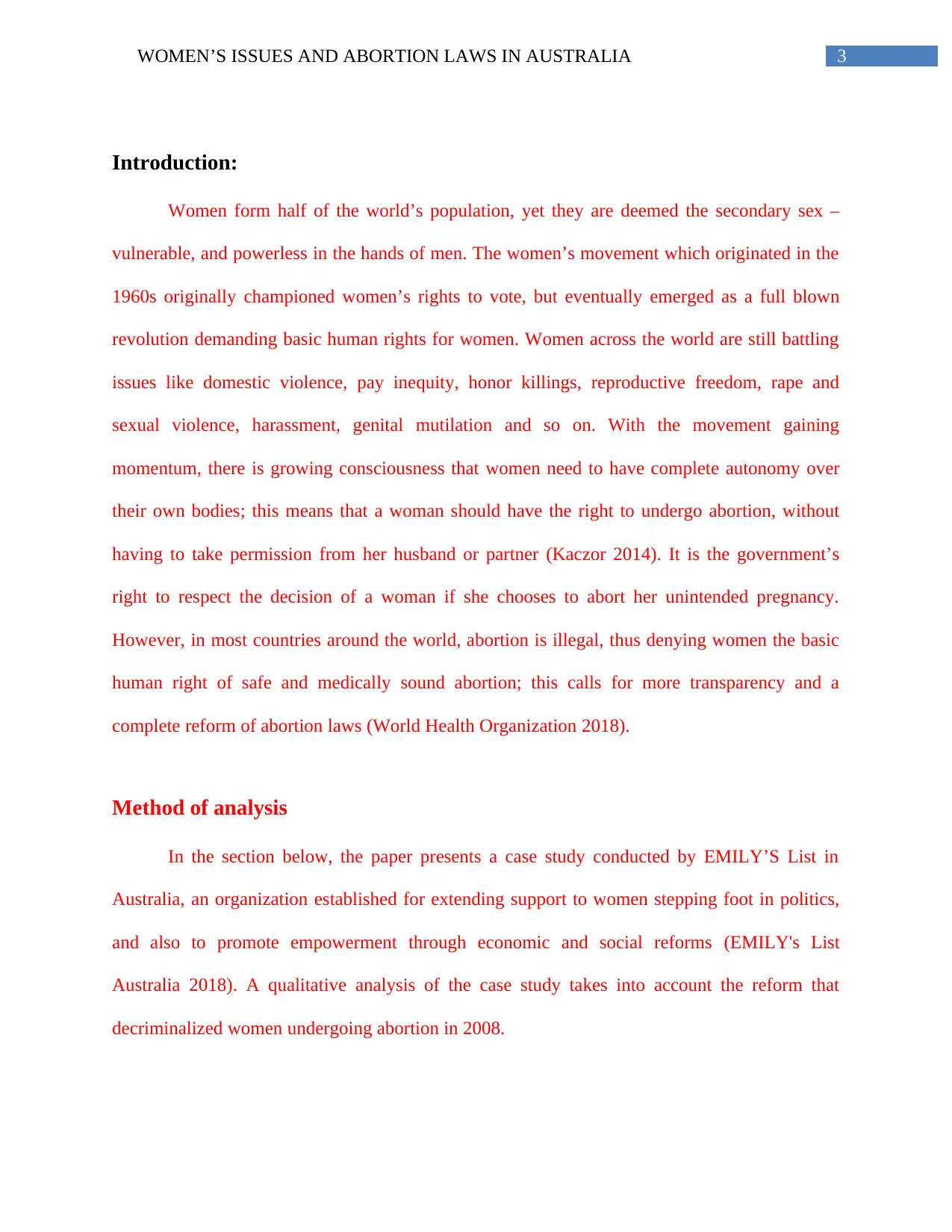
3WOMEN’S ISSUES AND ABORTION LAWS IN AUSTRALIA
Introduction:
Women form half of the world’s population, yet they are deemed the secondary sex –
vulnerable, and powerless in the hands of men. The women’s movement which originated in the
1960s originally championed women’s rights to vote, but eventually emerged as a full blown
revolution demanding basic human rights for women. Women across the world are still battling
issues like domestic violence, pay inequity, honor killings, reproductive freedom, rape and
sexual violence, harassment, genital mutilation and so on. With the movement gaining
momentum, there is growing consciousness that women need to have complete autonomy over
their own bodies; this means that a woman should have the right to undergo abortion, without
having to take permission from her husband or partner (Kaczor 2014). It is the government’s
right to respect the decision of a woman if she chooses to abort her unintended pregnancy.
However, in most countries around the world, abortion is illegal, thus denying women the basic
human right of safe and medically sound abortion; this calls for more transparency and a
complete reform of abortion laws (World Health Organization 2018).
Method of analysis
In the section below, the paper presents a case study conducted by EMILY’S List in
Australia, an organization established for extending support to women stepping foot in politics,
and also to promote empowerment through economic and social reforms (EMILY's List
Australia 2018). A qualitative analysis of the case study takes into account the reform that
decriminalized women undergoing abortion in 2008.
Introduction:
Women form half of the world’s population, yet they are deemed the secondary sex –
vulnerable, and powerless in the hands of men. The women’s movement which originated in the
1960s originally championed women’s rights to vote, but eventually emerged as a full blown
revolution demanding basic human rights for women. Women across the world are still battling
issues like domestic violence, pay inequity, honor killings, reproductive freedom, rape and
sexual violence, harassment, genital mutilation and so on. With the movement gaining
momentum, there is growing consciousness that women need to have complete autonomy over
their own bodies; this means that a woman should have the right to undergo abortion, without
having to take permission from her husband or partner (Kaczor 2014). It is the government’s
right to respect the decision of a woman if she chooses to abort her unintended pregnancy.
However, in most countries around the world, abortion is illegal, thus denying women the basic
human right of safe and medically sound abortion; this calls for more transparency and a
complete reform of abortion laws (World Health Organization 2018).
Method of analysis
In the section below, the paper presents a case study conducted by EMILY’S List in
Australia, an organization established for extending support to women stepping foot in politics,
and also to promote empowerment through economic and social reforms (EMILY's List
Australia 2018). A qualitative analysis of the case study takes into account the reform that
decriminalized women undergoing abortion in 2008.
Paraphrase This Document
Need a fresh take? Get an instant paraphrase of this document with our AI Paraphraser
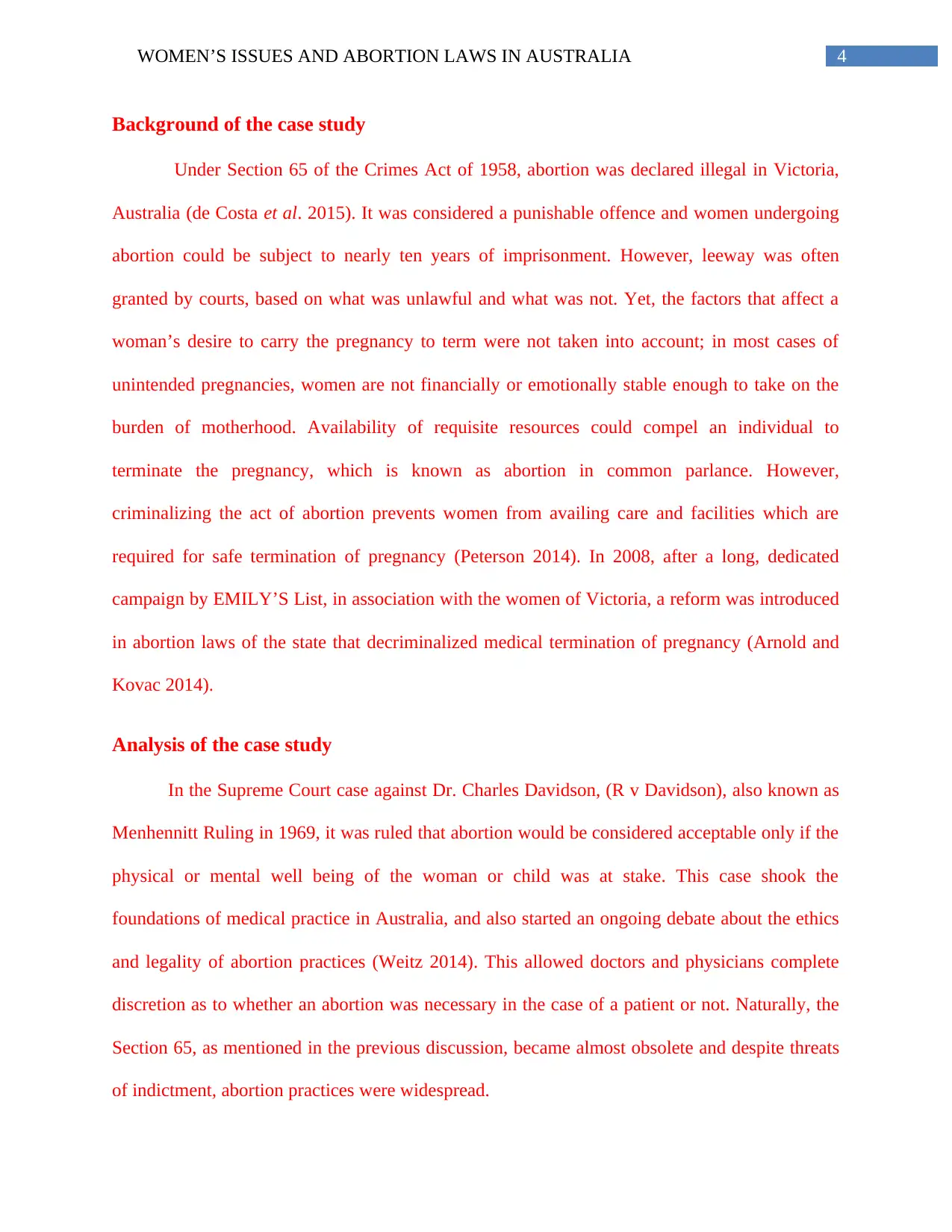
4WOMEN’S ISSUES AND ABORTION LAWS IN AUSTRALIA
Background of the case study
Under Section 65 of the Crimes Act of 1958, abortion was declared illegal in Victoria,
Australia (de Costa et al. 2015). It was considered a punishable offence and women undergoing
abortion could be subject to nearly ten years of imprisonment. However, leeway was often
granted by courts, based on what was unlawful and what was not. Yet, the factors that affect a
woman’s desire to carry the pregnancy to term were not taken into account; in most cases of
unintended pregnancies, women are not financially or emotionally stable enough to take on the
burden of motherhood. Availability of requisite resources could compel an individual to
terminate the pregnancy, which is known as abortion in common parlance. However,
criminalizing the act of abortion prevents women from availing care and facilities which are
required for safe termination of pregnancy (Peterson 2014). In 2008, after a long, dedicated
campaign by EMILY’S List, in association with the women of Victoria, a reform was introduced
in abortion laws of the state that decriminalized medical termination of pregnancy (Arnold and
Kovac 2014).
Analysis of the case study
In the Supreme Court case against Dr. Charles Davidson, (R v Davidson), also known as
Menhennitt Ruling in 1969, it was ruled that abortion would be considered acceptable only if the
physical or mental well being of the woman or child was at stake. This case shook the
foundations of medical practice in Australia, and also started an ongoing debate about the ethics
and legality of abortion practices (Weitz 2014). This allowed doctors and physicians complete
discretion as to whether an abortion was necessary in the case of a patient or not. Naturally, the
Section 65, as mentioned in the previous discussion, became almost obsolete and despite threats
of indictment, abortion practices were widespread.
Background of the case study
Under Section 65 of the Crimes Act of 1958, abortion was declared illegal in Victoria,
Australia (de Costa et al. 2015). It was considered a punishable offence and women undergoing
abortion could be subject to nearly ten years of imprisonment. However, leeway was often
granted by courts, based on what was unlawful and what was not. Yet, the factors that affect a
woman’s desire to carry the pregnancy to term were not taken into account; in most cases of
unintended pregnancies, women are not financially or emotionally stable enough to take on the
burden of motherhood. Availability of requisite resources could compel an individual to
terminate the pregnancy, which is known as abortion in common parlance. However,
criminalizing the act of abortion prevents women from availing care and facilities which are
required for safe termination of pregnancy (Peterson 2014). In 2008, after a long, dedicated
campaign by EMILY’S List, in association with the women of Victoria, a reform was introduced
in abortion laws of the state that decriminalized medical termination of pregnancy (Arnold and
Kovac 2014).
Analysis of the case study
In the Supreme Court case against Dr. Charles Davidson, (R v Davidson), also known as
Menhennitt Ruling in 1969, it was ruled that abortion would be considered acceptable only if the
physical or mental well being of the woman or child was at stake. This case shook the
foundations of medical practice in Australia, and also started an ongoing debate about the ethics
and legality of abortion practices (Weitz 2014). This allowed doctors and physicians complete
discretion as to whether an abortion was necessary in the case of a patient or not. Naturally, the
Section 65, as mentioned in the previous discussion, became almost obsolete and despite threats
of indictment, abortion practices were widespread.
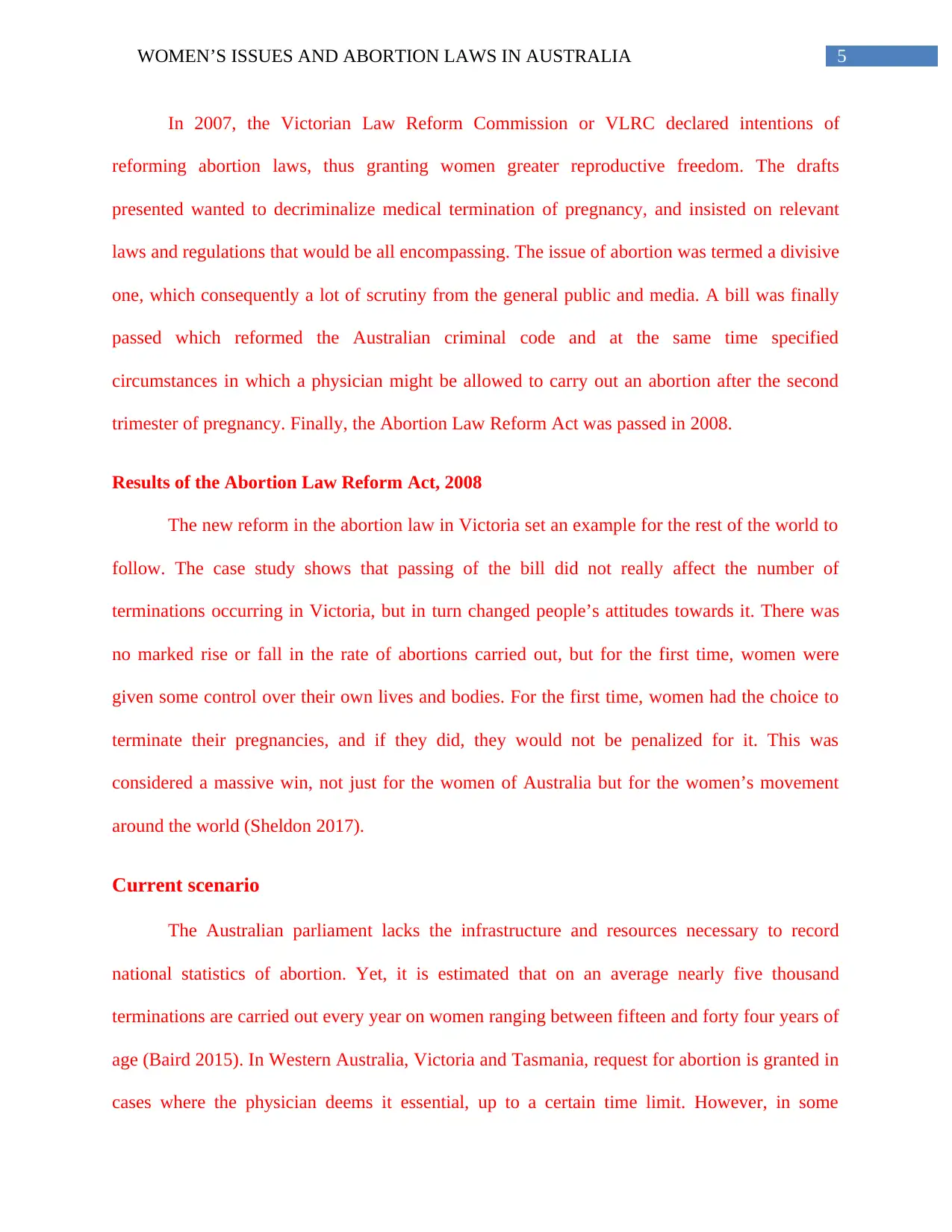
5WOMEN’S ISSUES AND ABORTION LAWS IN AUSTRALIA
In 2007, the Victorian Law Reform Commission or VLRC declared intentions of
reforming abortion laws, thus granting women greater reproductive freedom. The drafts
presented wanted to decriminalize medical termination of pregnancy, and insisted on relevant
laws and regulations that would be all encompassing. The issue of abortion was termed a divisive
one, which consequently a lot of scrutiny from the general public and media. A bill was finally
passed which reformed the Australian criminal code and at the same time specified
circumstances in which a physician might be allowed to carry out an abortion after the second
trimester of pregnancy. Finally, the Abortion Law Reform Act was passed in 2008.
Results of the Abortion Law Reform Act, 2008
The new reform in the abortion law in Victoria set an example for the rest of the world to
follow. The case study shows that passing of the bill did not really affect the number of
terminations occurring in Victoria, but in turn changed people’s attitudes towards it. There was
no marked rise or fall in the rate of abortions carried out, but for the first time, women were
given some control over their own lives and bodies. For the first time, women had the choice to
terminate their pregnancies, and if they did, they would not be penalized for it. This was
considered a massive win, not just for the women of Australia but for the women’s movement
around the world (Sheldon 2017).
Current scenario
The Australian parliament lacks the infrastructure and resources necessary to record
national statistics of abortion. Yet, it is estimated that on an average nearly five thousand
terminations are carried out every year on women ranging between fifteen and forty four years of
age (Baird 2015). In Western Australia, Victoria and Tasmania, request for abortion is granted in
cases where the physician deems it essential, up to a certain time limit. However, in some
In 2007, the Victorian Law Reform Commission or VLRC declared intentions of
reforming abortion laws, thus granting women greater reproductive freedom. The drafts
presented wanted to decriminalize medical termination of pregnancy, and insisted on relevant
laws and regulations that would be all encompassing. The issue of abortion was termed a divisive
one, which consequently a lot of scrutiny from the general public and media. A bill was finally
passed which reformed the Australian criminal code and at the same time specified
circumstances in which a physician might be allowed to carry out an abortion after the second
trimester of pregnancy. Finally, the Abortion Law Reform Act was passed in 2008.
Results of the Abortion Law Reform Act, 2008
The new reform in the abortion law in Victoria set an example for the rest of the world to
follow. The case study shows that passing of the bill did not really affect the number of
terminations occurring in Victoria, but in turn changed people’s attitudes towards it. There was
no marked rise or fall in the rate of abortions carried out, but for the first time, women were
given some control over their own lives and bodies. For the first time, women had the choice to
terminate their pregnancies, and if they did, they would not be penalized for it. This was
considered a massive win, not just for the women of Australia but for the women’s movement
around the world (Sheldon 2017).
Current scenario
The Australian parliament lacks the infrastructure and resources necessary to record
national statistics of abortion. Yet, it is estimated that on an average nearly five thousand
terminations are carried out every year on women ranging between fifteen and forty four years of
age (Baird 2015). In Western Australia, Victoria and Tasmania, request for abortion is granted in
cases where the physician deems it essential, up to a certain time limit. However, in some
⊘ This is a preview!⊘
Do you want full access?
Subscribe today to unlock all pages.

Trusted by 1+ million students worldwide
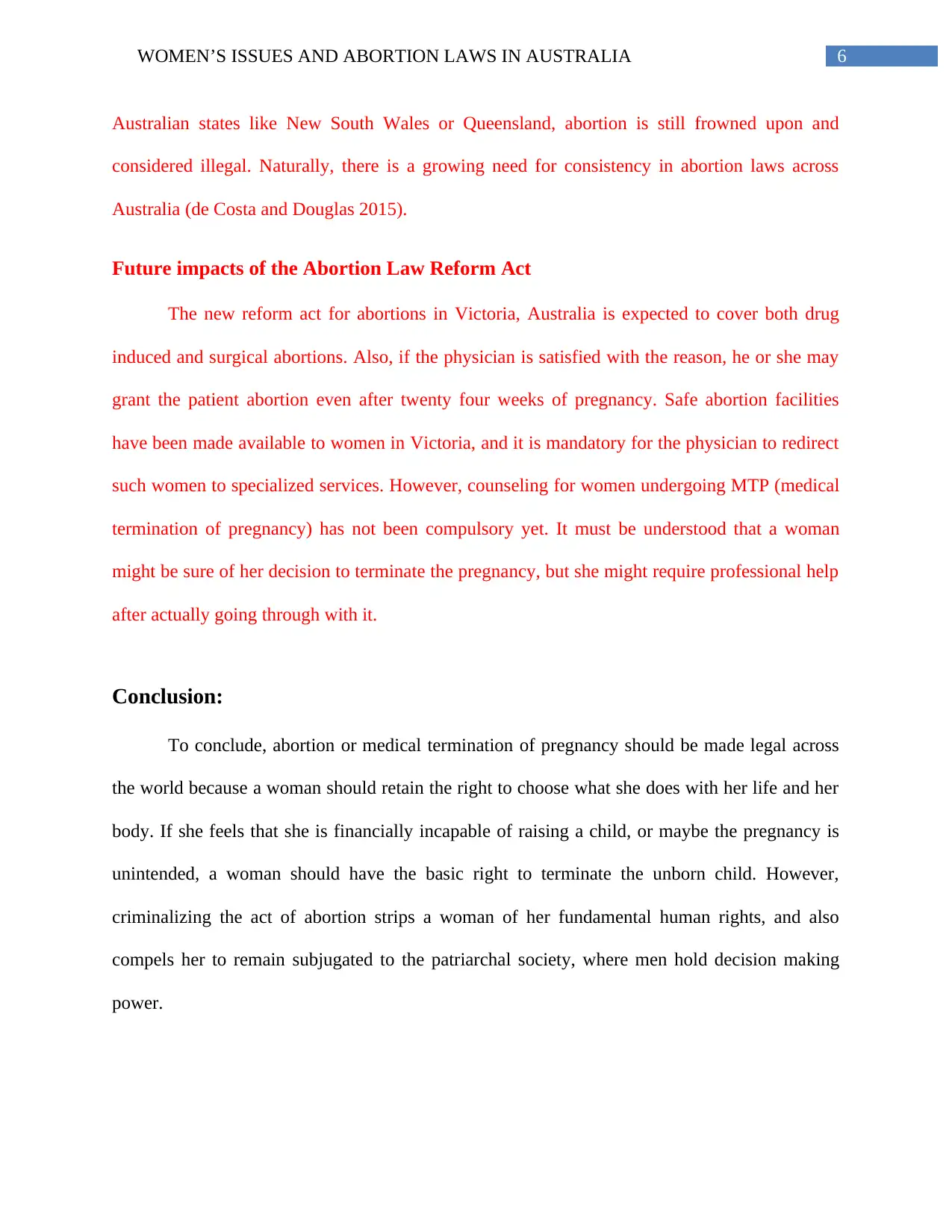
6WOMEN’S ISSUES AND ABORTION LAWS IN AUSTRALIA
Australian states like New South Wales or Queensland, abortion is still frowned upon and
considered illegal. Naturally, there is a growing need for consistency in abortion laws across
Australia (de Costa and Douglas 2015).
Future impacts of the Abortion Law Reform Act
The new reform act for abortions in Victoria, Australia is expected to cover both drug
induced and surgical abortions. Also, if the physician is satisfied with the reason, he or she may
grant the patient abortion even after twenty four weeks of pregnancy. Safe abortion facilities
have been made available to women in Victoria, and it is mandatory for the physician to redirect
such women to specialized services. However, counseling for women undergoing MTP (medical
termination of pregnancy) has not been compulsory yet. It must be understood that a woman
might be sure of her decision to terminate the pregnancy, but she might require professional help
after actually going through with it.
Conclusion:
To conclude, abortion or medical termination of pregnancy should be made legal across
the world because a woman should retain the right to choose what she does with her life and her
body. If she feels that she is financially incapable of raising a child, or maybe the pregnancy is
unintended, a woman should have the basic right to terminate the unborn child. However,
criminalizing the act of abortion strips a woman of her fundamental human rights, and also
compels her to remain subjugated to the patriarchal society, where men hold decision making
power.
Australian states like New South Wales or Queensland, abortion is still frowned upon and
considered illegal. Naturally, there is a growing need for consistency in abortion laws across
Australia (de Costa and Douglas 2015).
Future impacts of the Abortion Law Reform Act
The new reform act for abortions in Victoria, Australia is expected to cover both drug
induced and surgical abortions. Also, if the physician is satisfied with the reason, he or she may
grant the patient abortion even after twenty four weeks of pregnancy. Safe abortion facilities
have been made available to women in Victoria, and it is mandatory for the physician to redirect
such women to specialized services. However, counseling for women undergoing MTP (medical
termination of pregnancy) has not been compulsory yet. It must be understood that a woman
might be sure of her decision to terminate the pregnancy, but she might require professional help
after actually going through with it.
Conclusion:
To conclude, abortion or medical termination of pregnancy should be made legal across
the world because a woman should retain the right to choose what she does with her life and her
body. If she feels that she is financially incapable of raising a child, or maybe the pregnancy is
unintended, a woman should have the basic right to terminate the unborn child. However,
criminalizing the act of abortion strips a woman of her fundamental human rights, and also
compels her to remain subjugated to the patriarchal society, where men hold decision making
power.
Paraphrase This Document
Need a fresh take? Get an instant paraphrase of this document with our AI Paraphraser
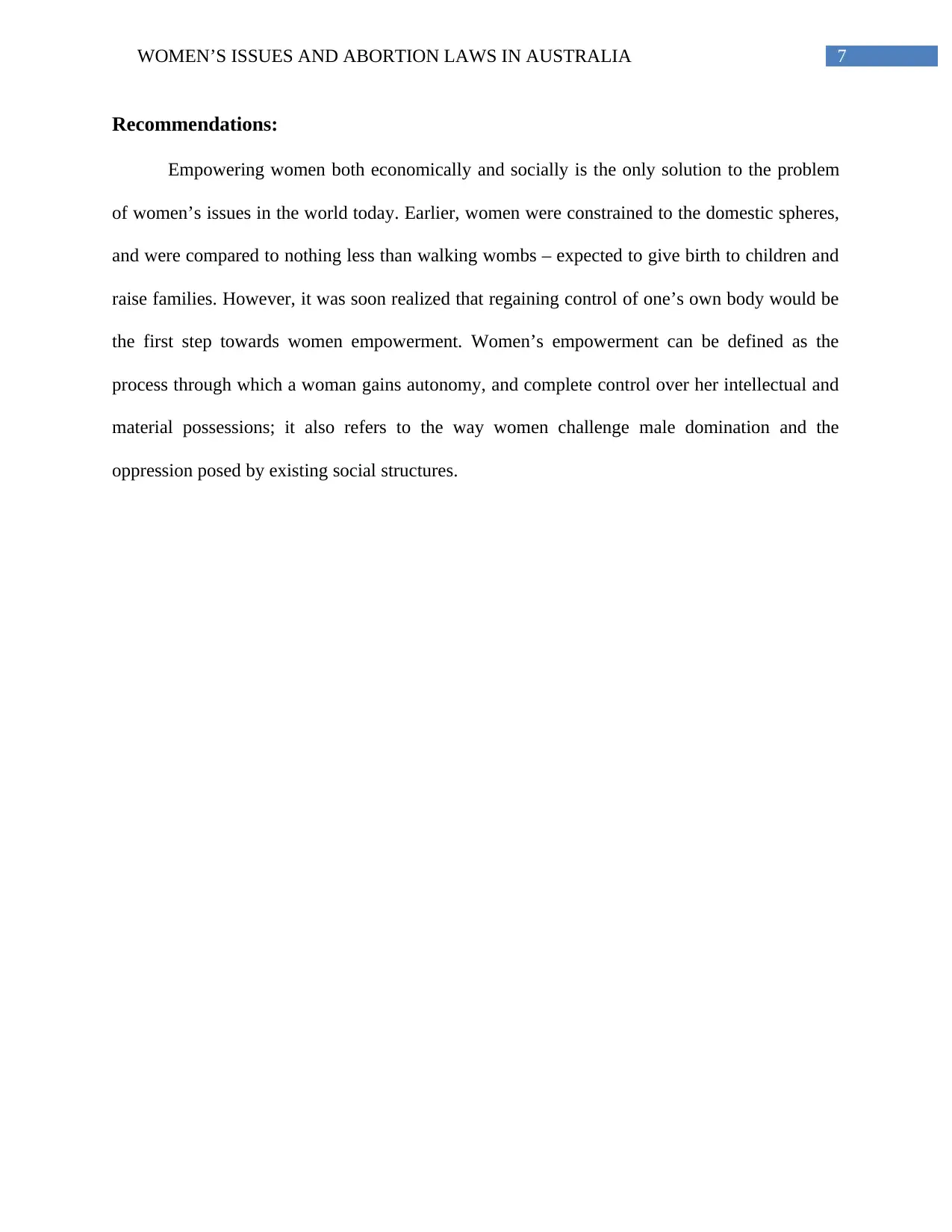
7WOMEN’S ISSUES AND ABORTION LAWS IN AUSTRALIA
Recommendations:
Empowering women both economically and socially is the only solution to the problem
of women’s issues in the world today. Earlier, women were constrained to the domestic spheres,
and were compared to nothing less than walking wombs – expected to give birth to children and
raise families. However, it was soon realized that regaining control of one’s own body would be
the first step towards women empowerment. Women’s empowerment can be defined as the
process through which a woman gains autonomy, and complete control over her intellectual and
material possessions; it also refers to the way women challenge male domination and the
oppression posed by existing social structures.
Recommendations:
Empowering women both economically and socially is the only solution to the problem
of women’s issues in the world today. Earlier, women were constrained to the domestic spheres,
and were compared to nothing less than walking wombs – expected to give birth to children and
raise families. However, it was soon realized that regaining control of one’s own body would be
the first step towards women empowerment. Women’s empowerment can be defined as the
process through which a woman gains autonomy, and complete control over her intellectual and
material possessions; it also refers to the way women challenge male domination and the
oppression posed by existing social structures.
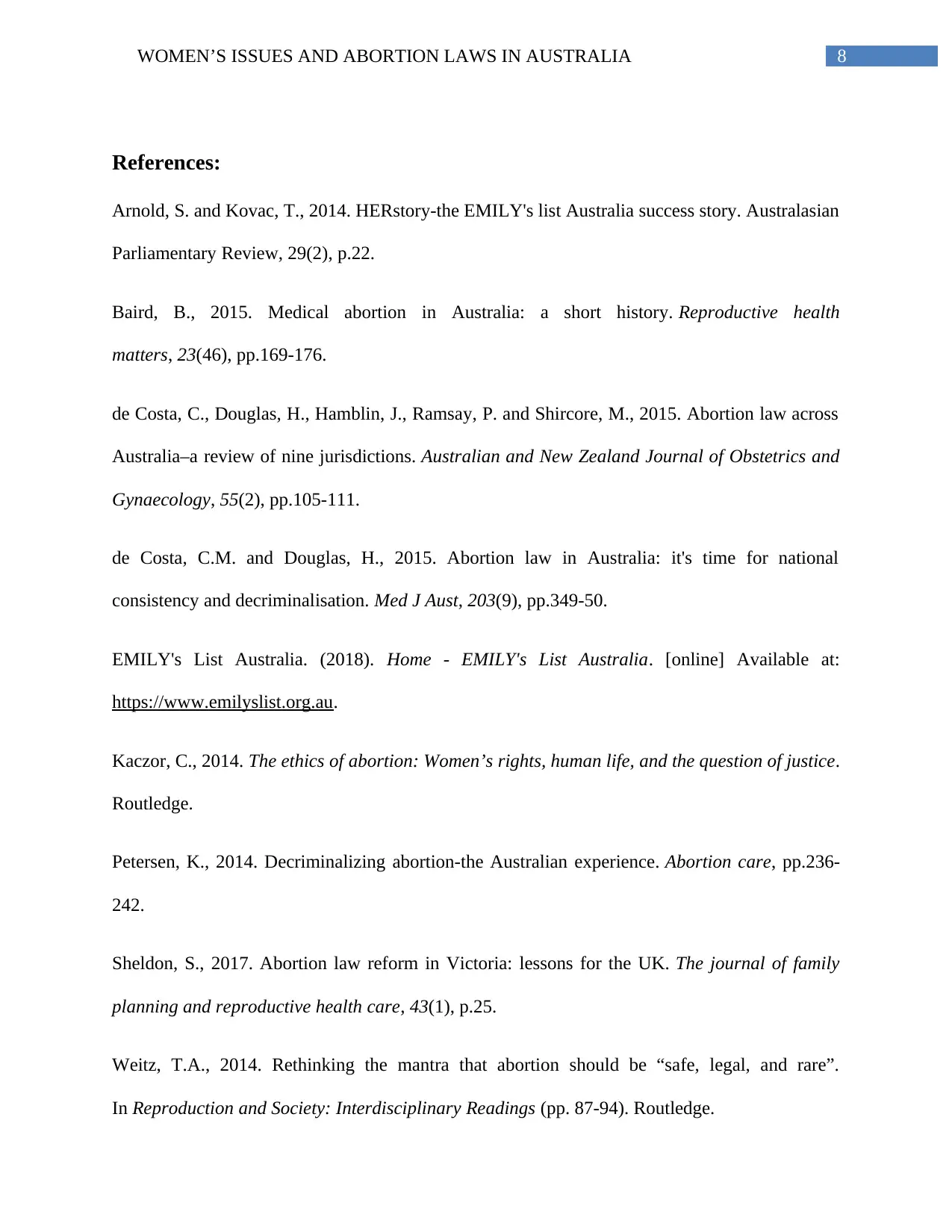
8WOMEN’S ISSUES AND ABORTION LAWS IN AUSTRALIA
References:
Arnold, S. and Kovac, T., 2014. HERstory-the EMILY's list Australia success story. Australasian
Parliamentary Review, 29(2), p.22.
Baird, B., 2015. Medical abortion in Australia: a short history. Reproductive health
matters, 23(46), pp.169-176.
de Costa, C., Douglas, H., Hamblin, J., Ramsay, P. and Shircore, M., 2015. Abortion law across
Australia–a review of nine jurisdictions. Australian and New Zealand Journal of Obstetrics and
Gynaecology, 55(2), pp.105-111.
de Costa, C.M. and Douglas, H., 2015. Abortion law in Australia: it's time for national
consistency and decriminalisation. Med J Aust, 203(9), pp.349-50.
EMILY's List Australia. (2018). Home - EMILY's List Australia. [online] Available at:
https://www.emilyslist.org.au.
Kaczor, C., 2014. The ethics of abortion: Women’s rights, human life, and the question of justice.
Routledge.
Petersen, K., 2014. Decriminalizing abortion-the Australian experience. Abortion care, pp.236-
242.
Sheldon, S., 2017. Abortion law reform in Victoria: lessons for the UK. The journal of family
planning and reproductive health care, 43(1), p.25.
Weitz, T.A., 2014. Rethinking the mantra that abortion should be “safe, legal, and rare”.
In Reproduction and Society: Interdisciplinary Readings (pp. 87-94). Routledge.
References:
Arnold, S. and Kovac, T., 2014. HERstory-the EMILY's list Australia success story. Australasian
Parliamentary Review, 29(2), p.22.
Baird, B., 2015. Medical abortion in Australia: a short history. Reproductive health
matters, 23(46), pp.169-176.
de Costa, C., Douglas, H., Hamblin, J., Ramsay, P. and Shircore, M., 2015. Abortion law across
Australia–a review of nine jurisdictions. Australian and New Zealand Journal of Obstetrics and
Gynaecology, 55(2), pp.105-111.
de Costa, C.M. and Douglas, H., 2015. Abortion law in Australia: it's time for national
consistency and decriminalisation. Med J Aust, 203(9), pp.349-50.
EMILY's List Australia. (2018). Home - EMILY's List Australia. [online] Available at:
https://www.emilyslist.org.au.
Kaczor, C., 2014. The ethics of abortion: Women’s rights, human life, and the question of justice.
Routledge.
Petersen, K., 2014. Decriminalizing abortion-the Australian experience. Abortion care, pp.236-
242.
Sheldon, S., 2017. Abortion law reform in Victoria: lessons for the UK. The journal of family
planning and reproductive health care, 43(1), p.25.
Weitz, T.A., 2014. Rethinking the mantra that abortion should be “safe, legal, and rare”.
In Reproduction and Society: Interdisciplinary Readings (pp. 87-94). Routledge.
⊘ This is a preview!⊘
Do you want full access?
Subscribe today to unlock all pages.

Trusted by 1+ million students worldwide
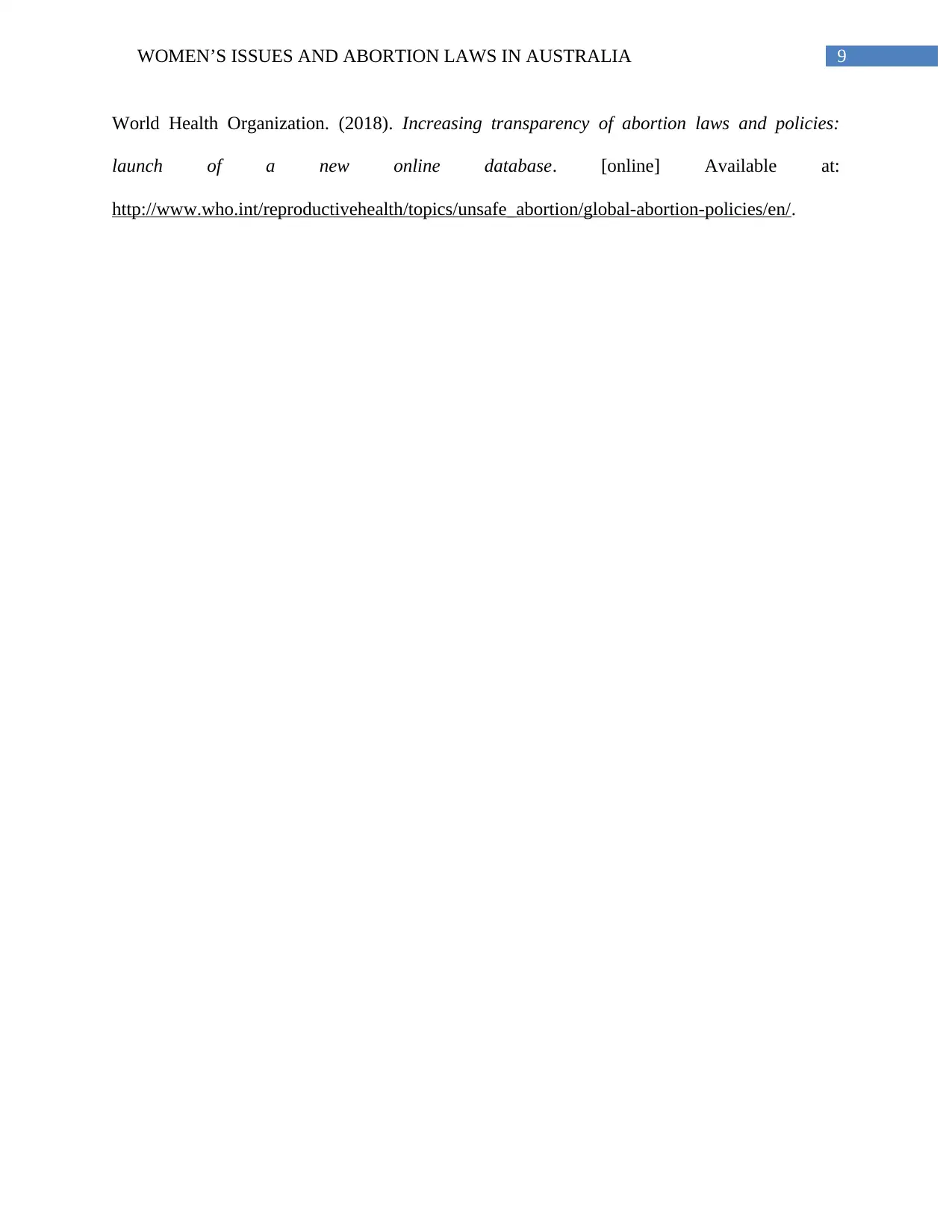
9WOMEN’S ISSUES AND ABORTION LAWS IN AUSTRALIA
World Health Organization. (2018). Increasing transparency of abortion laws and policies:
launch of a new online database. [online] Available at:
http://www.who.int/reproductivehealth/topics/unsafe_abortion/global-abortion-policies/en/.
World Health Organization. (2018). Increasing transparency of abortion laws and policies:
launch of a new online database. [online] Available at:
http://www.who.int/reproductivehealth/topics/unsafe_abortion/global-abortion-policies/en/.
1 out of 10
Related Documents
Your All-in-One AI-Powered Toolkit for Academic Success.
+13062052269
info@desklib.com
Available 24*7 on WhatsApp / Email
![[object Object]](/_next/static/media/star-bottom.7253800d.svg)
Unlock your academic potential
Copyright © 2020–2025 A2Z Services. All Rights Reserved. Developed and managed by ZUCOL.



